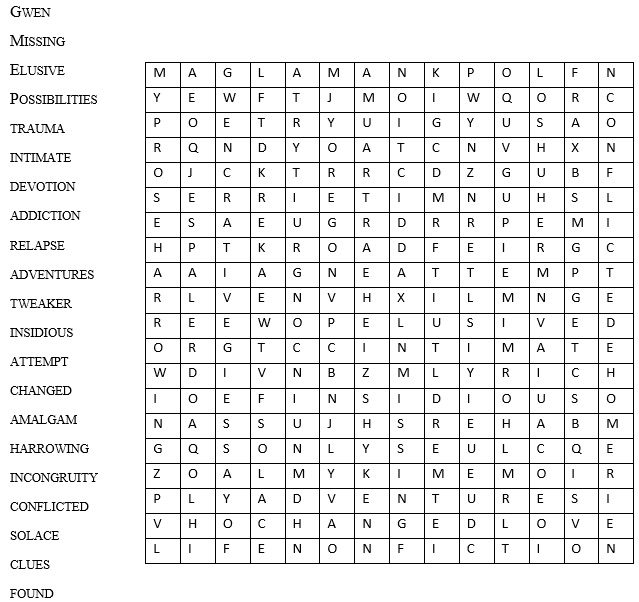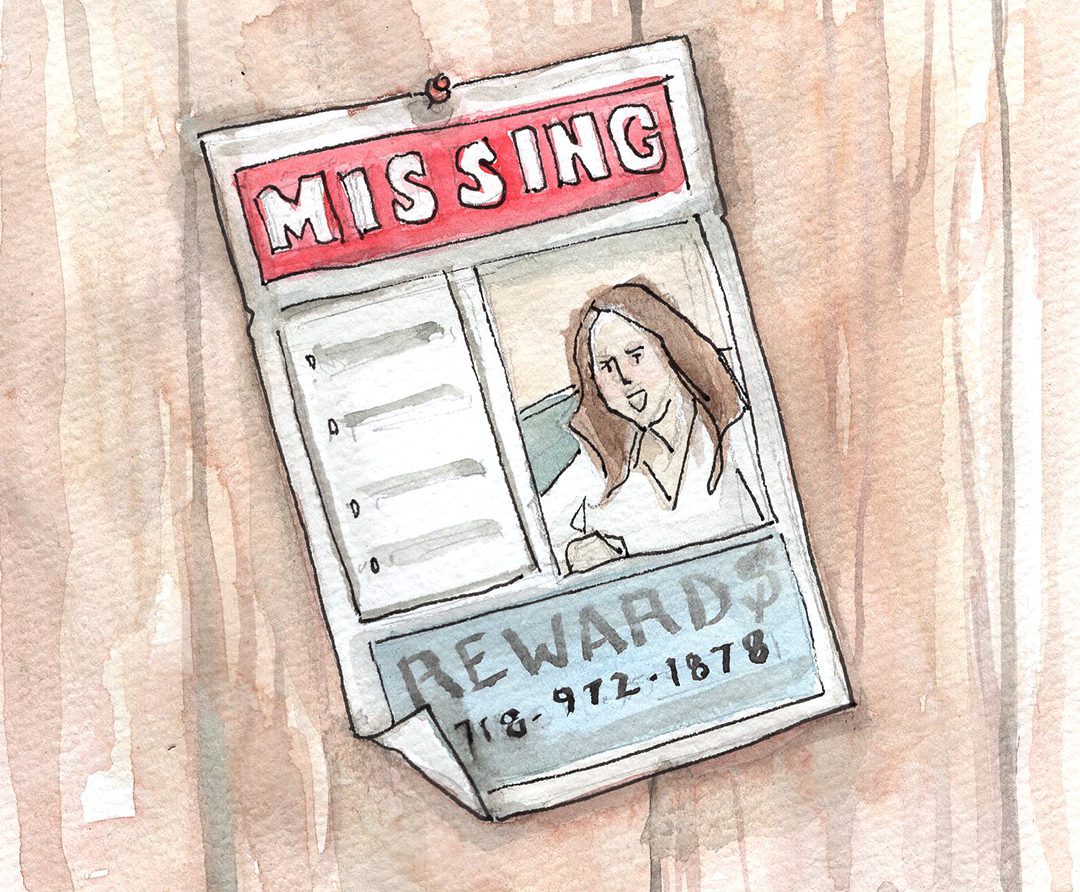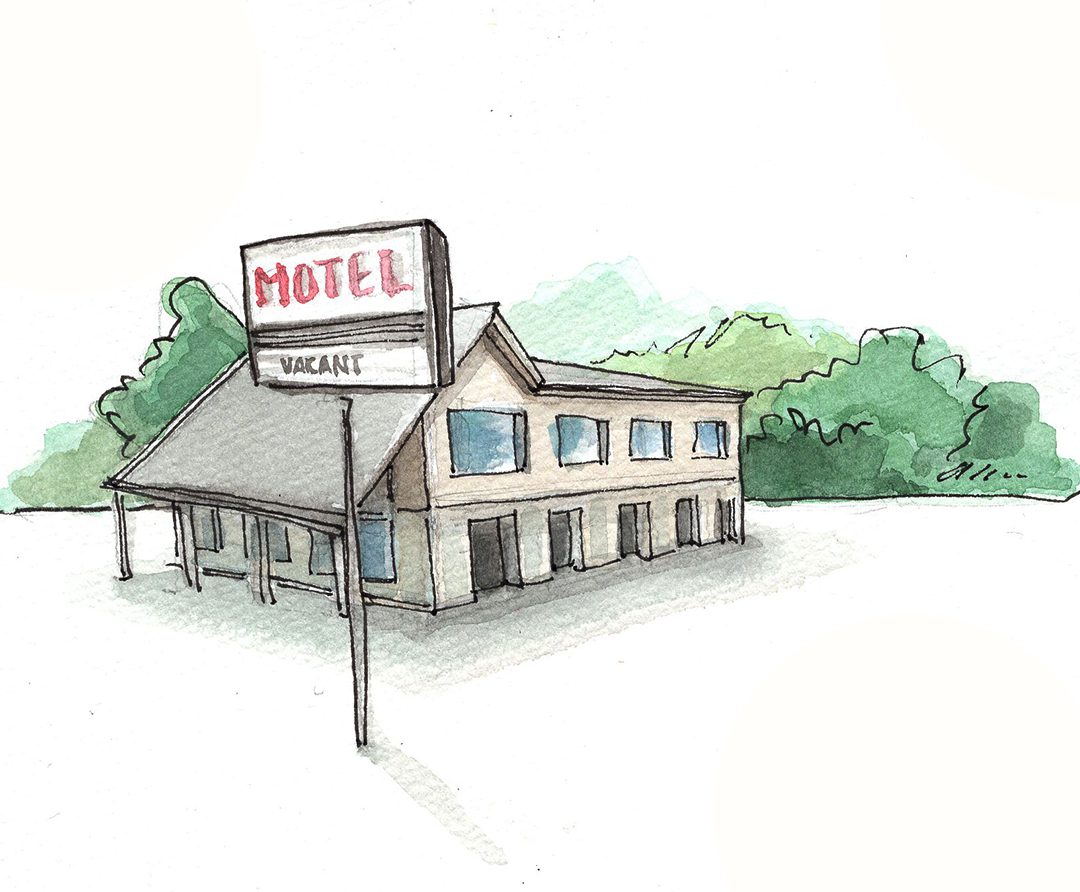1.
My friend has disappeared. The search poster says she was last seen on March 2, 2017. The font is a large block print in white on bright red. A warning. Her sweet face looks out from the page. This photo grips me like a fist squeezing my heart when I see the poster the first time. I am reminded of how she used to look—bright blue eyes; smooth, shiny, rosy skin; straight, white teeth, smiling. But this is not the sole cause of my reaction. Neither is the thought that that face could have come to harm. The squeezing heart-grip is because I know this photo. I took it. In my house. She is sitting on my couch, smiling at me through the lens. We were celebrating “Second Thanksgiving” in January, when my younger daughter was home from college for winter break, four years earlier. What this search poster photo doesn’t show is that next to her on the couch sits her six-year-old son. He grins, looking sideways from the camera, toward someone else. His head leans against his mother’s arm; her hand rests against his hair.
A couple weeks before this search poster was released, I had received a text from Gwen’s sister seeking information and help in finding her. Gwen’s family, who live on the East Coast, hadn’t heard from her for more than two weeks. She wasn’t answering her phone, and her voicemail box was full. In an ordinary situation, it could be rationalized that a grown adult might be busy and late in returning calls. But her life is not ordinary. Such rationalizations could not be justified. Her family notified authorities and have since hired a private investigator. She is currently listed as MISSING.
2.
Some missing people are never found. Some are never found alive. Some people don’t want to be found. They hide. From the law, from people they owe money to, from abusive ex-boyfriends. They hide out of fear or shame or because they are out of their minds. They are like smoke sifting through a screen—ELUSIVE.
3.
My imagination leaps in appalling bounds. Could she have been abducted? Is she the victim of human trafficking? Did her ex-boyfriend kill her in a drug-induced rage and dispose of her body? Did the stress of losing custody of her son and the havoc of a life destroyed by methamphetamine spur her to suicide? Is she holed up in an abandoned house, alone or with other addicts? Did she suffer a seizure, heart attack, or stroke from overdosing? Is she slipping past us on the rural highway, unsuspected in someone else’s rig, close yet unreachable. Or could she be in rehab? The ideal scenario, but not likely. So many POSSIBILITIES.
4.
Her family flew to Oregon to meet with the state police and private investigators. They held a meeting—to share and gather information that may lead to Gwen’s whereabouts—outside on an eighty-five-degree day at the community land in our small town. This is the land where my children once attended an alternative school, where I taught cooking, quilting, and crafts, that after much hard work and effort, failed to secure its charter. The land where my missing friend once taught my young daughters belly dancing and a father (of a boy) complained it was improper. The land I walked fourteen years prior as school pictures were being taken on a similar afternoon, yet one not so hot, while a different friend’s fifteen-year-old son was alone at home and hanged himself from a tree. This is the land I normally avoid because it holds memories deep in its soil the way a healed flesh wound holds scar tissue from TRAUMA.
5.
Here is the nature of my relationship with Gwen: when my twelve-year-old daughter was in the pediatric intensive care unit at Doernbecher Children’s Hospital in Portland, and I was at my most vulnerable because I didn’t know if my daughter would live or die, I made one phone call to a friend. She was the one. INTIMATE.
6.
When this same daughter was two years old, she used to follow my friend around our property as Gwen worked transplanting, watering, or weeding in our nursery. My daughter’s refrain then was “Only my Gwen.” An announcement. A claiming. I know this feeling. I feel it, too. No matter how many people love her, no matter how many close relationships she has had, I will always think of her as “only my Gwen.” DEVOTION.
7.
This is what happens when you smoke methamphetamine: it releases an onslaught of dopamine, producing a rush of intense pleasure, followed by a prolonged sense of euphoria that lasts between six and twelve hours. The amount of dopamine released is twelve times that of activities like sex or ingestion of alcohol or nicotine or certain foods. Dr. Richard Rawson, associate director of UCLA’s Integrated Substance Abuse Programs, says, “methamphetamine produces the mother of all dopamine releases.” After the drug wears off, depression counters the pleasure and euphoria, inciting repeated use of the drug to avoid turbulent crashes. Such behavior leads to ADDICTION.
8.
Once, a few years before Gwen disappeared, she called and said, “Will you come get all the alcohol out of my house? I need it out of here. Now.” I didn’t hesitate. She loaded me up with bottles of hard liquors, liqueurs, wine, and prescription pills not prescribed to her. I promptly placed them in the back of my car. We sat for a long time, discussing her addiction. I said, “Maybe you should go to AA,” knowing that if she didn’t get help, her newfound sobriety would likely be brief. She balked. “Oh, no. I could never do that,” she said. I offered to take her. She said she’d think about it.
A month later, she called. “Hey, Lore, I’d like to get my bar back,” she said.
“Your bar?” I said. What the fuck? I thought. “I gave it away.”
“You gave it away? But I just gave it to you to hold for a little while.”
“No, you didn’t.”
“What about the pills? Do you still have those?”
“No,” I said. “I threw them in the garbage.”
A few months after that, at her birthday party, she was so drunk, she floated naked in the hot tub, not buoyant above the water, but mostly submerged. Ophelia in the river before she drowned. RELAPSE.
9.
It wasn’t always fractures and chaos. There were times of sweetness and fun. There was the Oregon Country Fair. By day we sold velvet and lace halter tops, shawls, skirts, and dresses we had designed and sewn together. By night we roamed the oak-tree paths arm in arm so as not to lose one another. There was the trip to Arcata for her birthday to see Rickie Lee Jones in concert at Humboldt State University. We stopped at the Smith River along the way, stripped off our clothes and plunged into the icy green water. We lay on our backs bobbing above the rocks, water sluicing over and around our curves until our pale skin turned watermelon from the cold. Later, after the concert, we drove to Patrick’s Point, where we had set up a tent on the bluff above the ocean, and climbed into our sleeping bags, huddling together in the dark, all warmth and closeness, crashing waves and minty breath as we drifted into sleep. There was a trip to Bandon by the sea, Gwen newly pregnant, me seeking a reprieve from motherhood. When the VW bus we were driving broke down in Winston, rather than canceling our excursion, we left the vehicle at an auto repair shop and rented a car. We stayed at the Sea Star Hostel, ate fish and chips in the sunshine along the wharf with the seagulls, searched for agates on the beach. We trespassed on an abandoned blueberry farm for sale along Highway 1, where the blueberry bushes stood high above our heads, and drove far up Elk River Road until we found the perfect emerald swimming hole, down a steep trail, a hidden oasis. A couple years later, there was an overnight at the Greensprings Inn, soaking together in the Jacuzzi tub, singing as she played the guitar, and pulling her son on a sled in the snow the next morning. ADVENTURES.
10.
I ran into her ex-husband the day Gwen was summoned to an emergency court hearing because he had filed for temporary sole custody of their son. I was out walking with my family at a local nature preserve. Their son was subdued and walked away from us, downcast. He had just learned he would not be seeing his mother for a while. “She’s been making poor choices and hanging out with the wrong people,” her ex said. “I never would have thought she’d become a tweaker.” He did not say she had become a meth user. In fact, he did not know this as certainty. But everything implied it. The way her once good looks had faded from bright and lively to gaunt and strung out. The way her mood could swing and she’d surge into sudden rage and violence, like the episode that provoked the emergency hearing. The way she couldn’t seem to maintain a steady home, work, or previous years-long friendships. “TWEAKER” implied meth.
11.
Methamphetamine is made from pseudoephedrine (decongestant found in cold medicine) and other highly toxic ingredients, which can include acetone (nail polish remover or paint thinner), lithium (used in batteries), toluene (used in brake fluid), hydrochloric acid (used to make plastic), red phosphorus (found in matchboxes, road flares, and other explosives), sodium hydroxide (lye), sulfuric acid (used in drain and toilet bowl cleaner), and anhydrous ammonia (found in fertilizer and counter top cleaner).
This is what chronic smoking of meth does to a body and brain:
The outward physical effects include drastic weight loss, malnutrition, insomnia and sleep deprivation, dental decay, elevated body temperature and dehydration, sores and abscesses, and an aged appearance. The unseen effects can be irreversible damage to major organs such as the heart, lungs, liver, and kidneys. An overdose of meth can cause convulsions, heart attack, stroke, or death. Methamphetamine is a central nervous system stimulant that is neurotoxic. Chronic meth use damages the brain and causes chemical changes. Effects include psychotic symptoms, including paranoia, hallucinations, delusions, and self-absorption; aggression and violence due to a lack of impulse control; impaired thinking and judgment; memory loss; decreased attention span; anxiety; mood swings; reduced inhibition; compulsive motor actions like twitching or scratching; and an increased risk of stroke and Parkinson’s disease.
Many words describe how meth affects a life. But there is one word—its signature—that describes best what it is at its core: INSIDIOUS.
12.
Her Facebook posts turned dark and desperate, describing in text with pictures how her on-again, off-again boyfriend had trashed her rental and her car. One day, after she had been evicted and was living out of her car and a string of motels (when she could afford it), her rambling post read like a suicide note, addressed to her son as a goodbye letter, saying how tired she was and she just needed to close her eyes and dream of her son in a peaceful sleep. Alarm bells rang in my brain. I immediately called her phone but got no answer, so I messaged her on Facebook, pleading for a response; then I started calling motels. The first motel I called wouldn’t confirm if she was staying there. Against policy. I began asking every clerk I called for her room, and when they asked me for the room number, I feigned ignorance. They all came back saying there was no one by that name at their motel. That’s when I called the sheriff, but without knowing her location, there was nothing they could do. About an hour later, she messaged me back, telling me where to find her, adding “Please don’t send the cops here.”
She answered the motel door in a tank top and underwear, her hair stringy and hanging in her face, which looked ashen and haggard with dark patches under her eyes and an expression of both shame and relief at seeing me. The room was freezing because the air conditioner blasted on high, and the air smelled of an unfamiliar toxic chemical I could barely stand to breathe. I pulled a chair close to the bed to face her and said, “I’m here to help you, but you have to be honest with me. If you’re not, I’ll know it, and I’m outta here.”
I quizzed her, and she confessed to everything: using meth for nearly two years, how and when she started, having smoked it prior to my arrival, as well as prior to writing her distressing Facebook post. She said she couldn’t keep track of time. Not in the way regular people lose track and are late to an appointment, but in the way time shapeshifted so that she wasn’t sure what was actual and what was imagined. Whole chunks of time disappeared, and she didn’t know what had happened. She warned me she could “go from zero to a hundred” in an instant—one moment she’d be fine; the next she’d be enraged. And then she described an episode (one I had already heard about from another person’s perspective) with such clarity and accuracy (and conflicting with the other person’s account) that I felt certain she was fabricating the facts. Not lying directly. I think she truly believed what she was saying. It was more like her fabrication was the product of delusion. I expressed no doubt. This was a reconnaissance mission. My intention was to save her, not alienate her. ATTEMPT.
13.
We went out for dinner at the G Street Bar & Grill. She was in good spirits and mostly acted like her normal self (although an extremely hyped-up version), but as the evening passed, there was an obvious lack of balanced relating. It felt like she could hear my voice but wasn’t really listening to what I had to say. She showed no interest in the changes in my life since we had last seen each other sixteen months before. After dinner, we sat in the car in the parking lot, and a family walked by, a baby sitting on the man’s shoulders. I said, “You know I’m a grandma now.” She made no remark other than an insulting joke I can’t remember now and then started talking about something else. One might think she didn’t want to talk about grandchildren because losing custody of her son was too painful. Maybe some of that floated beneath the surface. Her behavior, though, didn’t express that much care, thought, or reflection. It revealed dissonance between the person I used to know and the one sitting beside me. That was the defining moment. I realized my old friend was gone. In her place sat a dysfunctional woman who had lost the ability to reason and care about others. By the time we got back to the motel, she was growing confused, agitated, and angry. I left her in the parking lot, searching through the back of her car, muttering to herself in an incoherent repetition, an edge of violence rising in her body. A person CHANGED.
14.
The vernacular used to refer to addiction and those who struggle with it has changed. Terms such as “meth addict” and “substance abuser” have become “person with a meth [or substance] use disorder.” Such terminology is believed to be person-centered and avoids characterizing one by his or her addiction. The transition away from substance “abuse” is meant to abate the negative moral judgments associated with the word. At the meeting on the community land with Gwen’s family, her sister reminded everyone that the last couple of years of Gwen’s struggle is only a blip in the timeline of her life. We, who have known her for longer than two years, know the essence of her being—devoted mother; talented musician and belly dancer; healing and intuitive massage therapist; pirate radio DJ spinning Bluegrass Tendencies; loving sister, daughter, and friend. A person is not one thing or another—addict or responsible adult—she is an AMALGAM.
15.
I said I would be her touchstone; she could call me when she needed grounding. I would help her focus, come up with strategies for recovery, and (hopefully) implement them. She called, agitated and struggling to make a to-do list. She couldn’t think straight. She couldn’t remember what she needed to write down. She said, “just hearing the sound of your voice helps.” “Do you want me to come?” I asked. “Yes,” she said.
When I arrived, she was on the phone with an insurance representative, trying to get approval for detox. She put the phone on speaker so I could listen. The woman expressed concern that if she went to detox without a bed waiting for her in a rehab center directly afterward, she would relapse and detox would have been futile. Gwen tried to remain calm. Her sole focus was the upcoming custody hearing. She wanted to show the court she was taking steps to get clean. But the insurance rep wouldn’t authorize approval, and this agitated Gwen, who had barely slept and not eaten since the day before. I started writing a to-do list for her—get an evaluation from Options (the local non-profit providing psychosocial rehab services), find a lawyer, get a new phone charger—when a Domino’s delivery guy knocked on the door. Gwen’s sister had called in a delivery order in hopes she would finally eat. The insurance phone call had stressed Gwen out, and she could barely hold the sandwich still because she was shaking so much. She bit into it aggressively. After one bite, she started a pattern of repeated muttering, like the night before. She babbled about needing her son, about wishing her abusive ex-boyfriend were there—if only she could see him and talk to him, everything would be better.
“Well, you can forget that. He’s the last thing you need.”
I had said the wrong thing. A deep, guttural roar erupted out of her. She rose and slammed her fists down hard on the table, inches from where I sat. It rocked from the force. She paced back and forth, tensing her fists, her arms, unadulterated rage hijacking her body. I have been in the presence of rage before. But this rage exploded in unmatched fury and vibrated at a frequency entirely unpredictable. Suddenly I was vibrating, too. But with fear. I felt certain she was going to attack me. Then she ran to the bathroom and shut herself inside, yelling in a rush, “Lore, you need to leave, you need to leave, I need you to leave, get out of here, you better get out of here, I need you to get out of here, Lore, now, go, get out of here!” I grabbed my bag and fled. I flew down the stairs, running for what felt like my life, afraid the colossal form of Lyssa, Greek goddess of fury and madness, would swoop into the stairwell and strike me down. HARROWING.
16.
As I drove home from the motel, past the lush, spring-green farms and fields, it was hard to reconcile the fact that here, in this place teeming with beauty and life and potential, lurked a pathology of people in drug-addled discord, an energy so harmful and frightening it hid amid the grass like a viper waiting to strike. INCONGRUITY.
17.
Gwen’s ex-husband’s lawyer called and asked if I would testify against her in court. Until I revealed that Gwen had confessed her meth use to me, they had no confirmation of her addiction, only suspicion and hearsay. The lawyer said my testimony would ensure “court ordered” treatment and put Gwen at the top of a substantial list for in-patient treatment. In Oregon, public rehab centers are maxed out. The wait is long. For a person suffering from methamphetamine addiction, such a wait can feel like a lifetime. A lifetime of continued damage to the brain and body. The lawyer said the goal was to get Gwen treatment so she could return to being an active part of her son’s life with shared custody. She laid out the protocol: detox; ninety-day in-patient rehab; and then a transition to a halfway house, where she would have support and therapy to reintegrate into living independently a life free of meth. During treatment, she could have access to her son, at first via phone calls and then in person. Court was in a week. I had to make a choice. Would I sacrifice our relationship to help save her life? Yes, absolutely, I thought. Maybe someday she’d forgive me. Even Gwen’s sister supported me in testifying. But then I thought about Gwen’s fragile state, the delicate trust she had instilled in me, how she had said, “You’re my only friend who isn’t a drug addict,” and I wasn’t sure if I could do it. With my testimony, the temporary full-custody order in favor of Gwen’s ex would become permanent. She’d hate me for that. CONFLICTED.
18.
Gwen found a lawyer who took her case pro bono, and they settled out of court. She signed an agreement requiring her to get treatment, just as her ex’s lawyer had described, and I was relieved of making the decision of whether to betray her. She never went to in-patient rehab. I could have testified against her, and it still wouldn’t have insured her recovery. It most likely would have ruined our friendship though. The last time I saw her she was evicting me from her motel room. It was tense and terrifying and unpredictable. But I knew she loved me. There is that, a bit of SOLACE.
19.
When Gwen went missing, her last phone call was to a friend on the East Coast. For Gwen, her phone was her lifeline. She remained tethered to it—until she lost it. She lost multiple phones in the last year leading up to her disappearance. Every time she lost one, she contacted her sister, who paid the phone bill, to get a replacement. After that last phone call, Gwen didn’t seek a new phone. The voicemail box filled up, and her family was no longer able to reach her. There were no sightings of Gwen or her car. Three months later, after her family hired a private investigator and the Oregon State Police agreed to take the case, Gwen’s car was found in the north end of Grants Pass, behind some motels, adjacent to Interstate 5. Authorities reviewed security footage, but the cameras record over old footage every week or so, so they came up with no new leads. I heard rumor the contents of her vehicle included her phone, laptop, and a tablet. All evidence remains in police custody. Her family continues to ask for prayers and everyone to “keep the faith” in hopes this information will help find her. CLUES.
20.
To deal with the fact that Gwen is missing, I have developed a numbness of spirit in her regard. I cannot linger too deeply in the questions of who, what, where, when, why, and how, for if I do, a sinking dread threatens to bury me. Sometimes it does. Temporarily. But then I squash it back into numbness. Numbness allows hope to thrive. That hope is a seedling that roots itself in a crack of concrete, defying heat, drought, and the soles of shoes in order to grow. This essay is my invocation. It calls on the missing and transforms her from elusive smoke sifting through a screen to something tangible. I wonder how Gwen might react to it. Gwen the addict would probably go nuts and rail against my words, positioning herself as the victim, blaming me for betraying her confidence and accusing me of an inaccurate portrayal. Gwen the person and friend not addicted to meth might feel some shame. Maybe some regret. Perhaps she would see her story as the story of a thousand others. Perhaps in reading this essay, she would be thankful to have lived through the story and come out the other side. I’m willing to take that gamble. I’m willing to risk her hating me. That would mean I’d see her again one day. That would mean she will be FOUND.
***
Rumpus original art by Lauren Kaelin.
***
Names appearing in this work have been changed.
***
Excerpted from A Harp in the Stars: An Anthology of Lyric Essays edited by Randon Billings Noble by permission of the University of Nebraska Press. © 2021 by the Board of Regents of the University of Nebraska.
Excerpted from All the Leavings by Laurie Easter. Copyright © 2021 by Laurie Easter. Reprinted by permission, courtesy of Oregon State University Press.
***
Voices on Addiction is a column devoted to true personal narratives of addiction, curated by Kelly Thompson, and authored by the spectrum of individuals affected by this illness. Through these essays, interviews, and book reviews we hope—in the words of Rebecca Solnit—to break the story by breaking the status quo of addiction: the shame, stigma, and hopelessness, and the lies and myths that surround it. Sisters, brothers, mothers, fathers, adult children, extended family members, spouses, friends, employers or employees, boyfriends, girlfriends, neighbors, victims of crimes, and those who’ve committed crimes as addicts, and the personnel who often serve them, nurses, doctors, social workers, therapists, prison guards, police officers, policy makers and, of course, addicts themselves: Voices on Addiction will feature your stories. Because the story of addiction impacts us all. It’s time we break it. Submit here.









